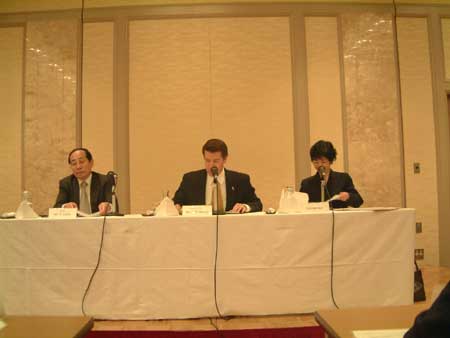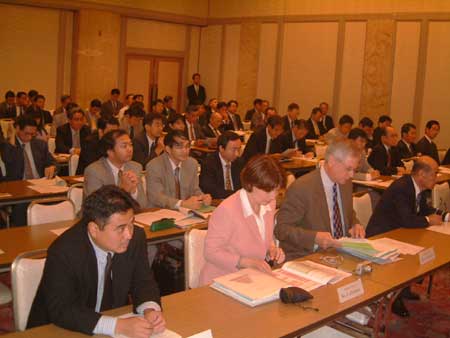|
Discussion with Dr. Runge, Administrator of NHTSA |
| *Date and Time: | ||
| Sept. 17, 2002 (Tuesday) from 3:30 to 5:30 p.m. | ||
| *Place: | ||
| Square Kojimachi, 3rd Flr., Nishiki Room | ||
| *Attendants from NHTSA: | ||
| Dr. Jeffrey
W. Runge Administrator, NHTSA Mr. Stephen Kratzke Associate Administrator, NHTSA Ms. Julie Abraham Director, Int'l Policy & Harmonization, NHTSA |
||
| Dr. Jeffrey W. Runge, Administrator, NHTSA, gave a
talk on US policy for safety regulations in light of regulations harmonization.
Upon completing his talk, Dr. Runge engaged in lively discussions
with attendants covering a broad range of topics, not only harmonization,
but also medical treatment after accidents. Synopsis of Dr. Runge's Talk As the United States continues to review harmonization of regulations with other countries, it is important to introduce regulations that are practicable in the United States. Although the 1998 Global Agreement and International Harmonized Research Activities (IHRA) mark a giant step forward in the advancement of harmonization, since results have not yet been forthcoming, specific potentials for harmonization are still not adequately disclosed. It is clearly evident that the objective is to guard safety and the environment. In the establishment of GTRs, debated under the 1998 Global Agreement, I believe it is important to ensure transparency and opportunities for participation by industry and the general public and to address particular safety and environmental problems while also preserving the sovereignty of each Contracting Party. In the establishment of GTRs, we will take the lead in several areas, including door locks and door retention components, child restraints and head restraints, and strive to complete GTRs. Harmonization is not simply adopting existing regulations of the United Nation's Economic Commission for Europe. It is important to change our existing standards to reflect best practices. The system of mutual approvals in Europe cannot be easily introduced into the United States. Adoptions will be made, however, if such things as performance requirements, test methods and test devices are examined in Geneva, if uniformity is attained, and if items match with systems in the United States. I sincerely hope that ample time is devoted to pursue cooperative efforts for harmonization so that favorable results are obtained. |
||
  |